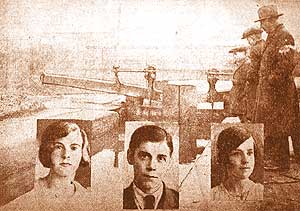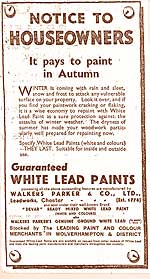![]()
The Peel Street Monster hunt
| January
18. Wolverhampton became a town of terror as the "Peel Street
Monster"roamed the Brickkiln Street area attacking children and attempting
to bite the throat of one pursuer.
After several attacks the monster was eventually tracked down by 17-year-old resident, George Goodhead, who slew the "miniature monster" with a brick on waste ground in Brickkiln Street after someone drew his attention to a strange animal lurking nearby. "I went and saw a queer animal , far too big for a rat, leaping towards a child about five-year-old," said George. "I shouted and the thing turned on me. It crouched, its eyes bulging, then it leaped like lightning." George added that he had picked up a brick and hit the male animal as hard as he could with it as it neared his throat. The animal lay twitching in a pool of water and locals gathered round and kicked it until it was dead. But the death of the monster raised another mystery. What was it ? Naturalists, taxidermists and vets were called in to identify the animal without success. Someone suggested it could be an ant-eater. The experts confessed to being baffled and it was suggested that the creature could become a serious rival to the Loch Ness Monster. But the mystery did not rest there. Within 24 hours of the slaying a second monster - a female - was found dead in the Brickkiln-Croft area and was this time identified as a coatimundi, a tree-climbing animal of the racoon type from South America. And fresh fears arose in Wolverhampton as rumours spread that there may be a colony of the creaturs hiding in partly closed cellars. Hundreds of people gathered in Salop Street to watch council workers trying to ascertain if a colony of the creatures were hiding there. The crowds were so great they hampered the efforts of the official rat-catcher. In the search, weapons brought in to confront any coatimundis found included poison gas, traps, sulphur terriers and ferrets. It was uncertain whether the ferrets were to be used following a suggestion that they might form part of the coatimundi diet. Officials said later that they believed there were no more coatimundis in the area - but the origin of those found remained a mystery.
TV - it will
never catch on! In an interview with Express & Star writer, Peter Rhodes, he recalled a human face, looking alarmingly like the Turin Shroud, appearing fuzzily in the lens of his home-made TV at his Wolverhampton home. Television had arrived in the Black Country. But the then young inventor didn't recall being aware of witnessing the future. "I remember people saying it would never catch on and was a waste of money - but they said the same about cars," he said. Mr Lampitt's 1934 TV model was eventually handed over to the Science Museum in London.
A witness, Gertrude Robinson, described what happened. "Suddenly I saw Martha take a step and disappear into the fog. I couldn't see anything, but I heard Martha cry out," she went on. Miss Robinson said George announced he was going in after her, tore off his coat and plunged into the water. All the time Martha was crying out. She said that the fog hampered police bids to find the couple a short while after the incident. "When they did find Martha and George Pritchard, it was too late," added Miss Robinson.
Coat, not coati . . . Not so much a coati as a coat hunt going on in the advertisement above from Willsons of Dudley Street Wolverhampton in 1934 - although there looks to be fur aplenty available. Below is the usual message to the DIY brigade - fix your place up before the weather turns bad. "It's wise to paint with White Lead Paint" said the ad . . . although experts might disagree these days. |
|
 In 1934. Robert Lampitt took an old electric motor, a sheet of plywood
and his mum's flat iron to assemble what was probably the first
hand-built TV in the Black Country. In the mid-nineties Mr Lampitt,
by then a pensioner, couldn't help chuckling about how different
the world was in those pioneering days.
In 1934. Robert Lampitt took an old electric motor, a sheet of plywood
and his mum's flat iron to assemble what was probably the first
hand-built TV in the Black Country. In the mid-nineties Mr Lampitt,
by then a pensioner, couldn't help chuckling about how different
the world was in those pioneering days.


